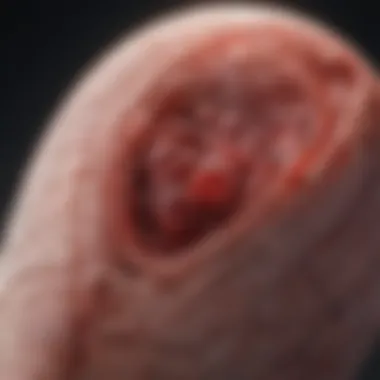Understanding PNH Anemia: Insights and Implications


Intro
Paroxysmal Nocturnal Hemoglobinuria (PNH) stands as a unique and complex condition that poses a significant challenge in the realm of hematology. This disorder occurs when red blood cells are destroyed prematurely, leading to a variety of symptoms that can dramatically affect a person's quality of life. Understanding PNH is crucial, not just for the healthcare professionals who treat it, but also for those who research its underlying mechanisms and develop innovative treatments for it.
PNH is indeed rare, but it carries life-threatening implications. Patients may experience fatigue, hemoglobinuria, and other concerning signs due to the destruction of red blood cells. As we delve into this topic, we aim to illuminate the various aspects of PNH, including how it manifests in patients, the critical diagnostic tests, and the current treatment options available. This article serves as an essential resource for a diverse audience – students aiming for a rich understanding, researchers looking to enhance their insights, and healthcare professionals needing updates on management strategies.
Overview of Research Topic
Brief Background and Context
To truly grasp what PNH entails, it’s helpful to look back at its historical context. First recognized in the 19th century, PNH has evolved from a mere curiosity in medical annals to a recognized hematological condition that beckons greater scrutiny. This disorder arises from a mutation in the PIGA gene, which is responsible for creating a protein that protects the surface of red blood cells. Without this protective barrier, the immune system mistakenly targets these cells, leading to their premature destruction.
Importance in Current Scientific Landscape
Today, research surrounding PNH is gaining traction. With new treatments emerging and a better understanding of its pathophysiology, the scientific community is edging closer to more effective management strategies. In addition, the advent of advanced diagnostic tools has created opportunities to identify PNH much earlier than before, allowing for timely intervention. The implications of these advancements cannot be overstated; as more people become aware of PNH, better treatment pathways and outcomes are expected to follow.
"Understanding PNH helps us to navigate complex patient scenarios, ensuring they receive comprehensive care tailored to their needs."
Interest in PNH is not merely an academic pursuit. As the global population ages and healthcare becomes more proactive, the quest to unveil the intricacies of rare diseases like PNH becomes paramount. This has prompted funding, research initiatives, and collaborative projects focusing on how to improve patient outcomes.
As we continue in this article, the next sections will explore diagnostic criteria, clinical manifestations, treatment options, and more, providing readers with a holistic view of PNH and its significance in the medical field.
Foreword to PNH Anemia
Paroxysmal Nocturnal Hemoglobinuria, or PNH, stands apart in the world of rare blood disorders. Understanding PNH Anemia carries significance for a multitude of reasons, especially within medical communities. PNH poses unique challenges owing to its complex pathophysiology and variety of clinical manifestations. By delving into its nature, researchers and healthcare providers gain insights into detection and treatment, ultimately improving patient outcomes.
Definition and Overview
PNH is defined as an acquired disorder characterized by the destruction of red blood cells and the presence of hemoglobin in the urine, particularly during the night. This rarity often masks the disease, making early diagnosis tricky. The condition stems from mutations in hematopoietic stem cells, leading to the absence of glycosylphosphatidylinositol (GPI) anchors, crucial for protective proteins on cell surfaces. As a result, red blood cells become prone to destruction by the body's immune system.
The clinical impact can vary greatly—to some, it might be a mild inconvenience, while for others, it can lead to severe health complications. Symptoms can include fatigue, dark-colored urine, and increased susceptibility to blood clots. Recognizing these early signs is key to timely and effective intervention.
Historical Context and Discovery
Tracing the roots of PNH reveals a history marked by curiosity and scientific inquiry. The first accounts hinting at PNH surfaced in the late 19th century, but it wasn't until the 20th century that definitive discoveries were made. The term itself appears in the medical literature around the 1920s, as physicians began to connect the dots between the odd presentations they observed and hemolytic processes.
One pivotal moment in understanding this condition was the discovery of the relationship between PNH and the complement system—part of the immune response. The groundbreaking research conducted throughout the decades shapes our current comprehension of PNH today, including its diagnosis and management.
Thus, the exploration of PNH not only informs clinical practice but also shapes future research directions. Understanding the historical context of its discovery allows students and professionals alike to appreciate the evolution of medical knowledge surrounding this anomaly.
"Every discovery begins with a question, and in the realm of medicine, the answers often lead to new inquiries."
In summary, acknowledging both the definition and historical backdrop of PNH Anemia lays a foundational understanding that benefits all stakeholders involved—be it direct care providers or medical researchers.
Pathophysiology of PNH
The pathophysiology of Paroxysmal Nocturnal Hemoglobinuria (PNH) is a cornerstone in comprehending how this rare hemolytic anemia wreaks havoc on the human body. Understanding the underlying mechanisms is crucial, as it provides insight into the symptoms, potential complications, and avenues for treatment. Abnormalities at the genetic and molecular level culminate into the clinical manifestations observed in PNH patients, making this exploration vital for healthcare professionals, researchers, and students examining this condition.
Gene Mutations and Mechanisms
At the heart of PNH lies a mutation in the PIGA gene, located on the X chromosome. This gene is crucial in the synthesis of glycosylphosphatidylinositol (GPI) anchors, which serve as a sort of molecular glue attaching proteins to cell surfaces. When there's a hitch in this process, red blood cells lose important proteins that help protect them from destruction.
More specifically, the PIGA mutation hampers the production of GPI-anchored proteins, leading to a deficiency of key molecules such as CD55 and CD59. These proteins play a significant role in inhibiting the complement system, a part of the immune system that marks pathogens for destruction. Without these protective proteins, red blood cells become like sitting ducks; they are prone to complement-mediated lysis. It’s a classic case of "survival of the fittest," but in this scenario, the red blood cells are anything but. As they face destruction, hemoglobin is released into the bloodstream, leading to hemoglobinuria, particularly noted during episodes of nocturnal hemolysis.
Complement System Activation
The complement system is an essential part of our immune defense, responsible for identifying and eliminating pathogens. In a healthy individual, this system is tightly regulated; however, in patients with PNH, the deregulated activation of this system has serious implications.
Due to the absence of the protective GPI-anchored proteins, the complement system goes unabated and mistakenly targets the body’s own red blood cells. During this attack, complement proteins systematically bind to these cells and initiate a cascade of actions that eventually lead to hemolysis. The repeated cycles of hemolysis can cause hemoglobin spills into the plasma, which, in turn, leads to renal issues because the kidneys filter this excess hemoglobin out of the blood. Thus, one can see how delicate the balance of immunological defense can turn into a double-edged sword.
Role of GPI-Attached Proteins


GPI-anchored proteins perform an array of functions that are essential to maintaining the viability of red blood cells. Most notably, CD55 and CD59 are pivotal in modulating the complement response. Their absence not only leaves red cells vulnerable but also results in downstream complications affecting other organs and systems.
In PNH patients, increased levels of complement activation products such as C3b and C5b-9 can be found circulating in the bloodstream, serving as markers of activated complement. This deregulation can lead to not only severe anemia driven by hemolysis but also complications like thrombosis, which some studies suggest can occur due to the hypercoagulable state induced by complement activation.
"Understanding the pathophysiology of PNH is crucial for both diagnosing and effectively managing this complex condition. The interplay between genetic factors, complement system activation, and the role of GPI-anchored proteins lays a foundation for therapeutic strategies."
In summary, the interplay of gene mutations, abnormal complement activation, and dysfunctional GPI-anchored proteins creates a storm that the body struggles to weather. This knowledge helps shape clinical approaches and informs ongoing research, drawing attention to the underlying complexities of Paroxysmal Nocturnal Hemoglobinuria.
Clinical Manifestations
Understanding the clinical manifestations of Paroxysmal Nocturnal Hemoglobinuria (PNH) is not just important, it’s crucial. This section dives into how PNH presents itself in patients, shedding light on the signs and symptoms that often serve as the first indicators of this rare condition. Recognizing these manifestations can significantly influence both diagnosis and treatment strategies, ultimately affecting patient outcomes.
Symptomatology
The symptomatology of PNH can be quite diverse and complex. Patients often report symptoms that range from vague fatigue to more specific signs such as hemoglobinuria, where hemoglobin is excreted in the urine, typically after periods of sleep. This can lead to dark-colored urine upon waking, a hallmark sign of PNH. Other potential symptoms include:
- Intermittent abdominal pain: This can occur due to hemolysis and subsequent complications.
- Shortness of breath: Decreased red blood cells can lead to oxygen deficiency.
- Pallor: Reduced hemoglobin levels cause noticeable paleness of the skin.
- Dizziness or lightheadedness: Particularly when standing up suddenly, and this can result from anemia-induced low blood pressure.
It's vital that healthcare professionals are vigilant in asking patients about these symptoms. A thorough history taking can often reveal patterns that may trigger further investigation into PNH.
Chronic Complications
Living with PNH can lead to chronic complications. These are often a result of ongoing hemolysis and the various effects it has on the body. Some chronic issues patients might face include:
- Thromboembolic events: Due to altered blood flow and hypercoagulability, individuals with PNH are at an increased risk for blood clots. This can lead to more serious complications such as strokes or pulmonary embolism.
- Organ damage: Recurrent hemolysis may damage organs over time, particularly the kidneys and the liver.
- Increased susceptibility to infections: As the body's immune system takes hits, patients may find themselves falling ill more frequently.
This chronicity of complications can create a significant burden on both the patients and healthcare systems. Monitoring these issues is essential for optimizing patient care and potentially improving their quality of life.
Acute Hemolysis Events
Acute hemolysis events are another pressing concern in managing PNH. These episodes can develop unexpectedly, resulting in sudden and severe symptoms. Often triggered by factors such as infections, stress, or even certain medications, an acute hemolysis event may manifest through:
- Rapid decline in hemoglobin levels: This might be associated with worsening fatigue and overall malaise.
- Jaundice: The breakdown of red blood cells can lead to increased bilirubin levels, resulting in yellowing of the skin and eyes.
- Pain crisis: Many patients experience crises that can cause intense discomfort, often requiring immediate medical intervention.
"Prompt recognition of acute hemolysis is vital for preventing severe complications and ensuring effective management strategies are employed."
Understanding these acute events and their implications can guide healthcare professionals in implementing timely interventions to mitigate the impacts on patients. Through a comprehensive approach to recognizing and managing the clinical manifestations of PNH, we can significantly enhance the overall care for affected individuals.
Diagnosis of PNH
Diagnosing Paroxysmal Nocturnal Hemoglobinuria (PNH) poses certain challenges, reinforcing the need for a robust approach. Delaying or misdiagnosing may lead to significant patient complications. Here, we explore the elements that contribute to a thorough diagnosis of PNH, including essential evaluations, laboratory tests, and differential diagnosis considerations. This will clarify how understanding these aspects can support healthcare professionals in delivering timely treatment.
Initial Evaluation and History Taking
An accurate diagnosis often begins with a detailed patient history. The physician needs to gather comprehensive information about the patient’s symptoms, medical history, and family background. Key factors such as recurrent or unexplained symptoms—fatigue, hemoglobinuria (hemoglobin in urine), or abdominal pain—should be noted.
During the interview, the use of targeted questions can unveil crucial details:
- Have symptoms worsened at night or after physical exertion?
- Are there any previous diagnoses of anemia?
- Any history with blood disorders in the family?
Such probing can help in identifying the characteristic symptoms of PNH early on.
Laboratory Tests and Findings
In diagnosing PNH, laboratory tests are indispensable. Two prominent methods stand out: Complete Blood Count Analysis and Flow Cytometry. Each plays a critical role in revealing the underlying anomalies of PNH.
Complete Blood Count Analysis
Complete Blood Count Analysis provides a comprehensive overview of the blood. This test assesses various components, such as:
- Red Blood Cell Count: In PNH, patients often exhibit low levels of red blood cells, indicating anemia.
- Hemoglobin Levels: Elevated hemoglobin levels in urine suggest hemolysis, a common feature in PNH.
The simplicity and rapid turnaround of this analysis make it a popular first-line test. What sets this method apart is its capability to highlight typical abnormalities associated with anemia while being non-invasive. However, it does not definitively diagnose PNH, as it requires confirmation through more specialized testing.


Flow Cytometry
Flow cytometry shines when specifically diagnosing PNH due to its ability to analyze the surface markers of red blood cells. This test focuses on detecting the absence of GPI-linked proteins on cell membranes, a hallmark of PNH cells. The advantages of flow cytometry include:
- High Sensitivity: It can detect even small populations of PNH cells among healthy ones.
- Speed: Results are available quickly, providing timely insight into the diagnosis.
However, flow cytometry requires technical expertise. If not performed correctly, it may lead to misinterpretations.
Differential Diagnosis
Differential diagnosis plays a crucial role in validating a PNH diagnosis. Symptoms of PNH often overlap with other conditions such as autoimmune hemolytic anemia or other types of hemolytics. Therefore, it’s essential to distinguish PNH from these alternatives through various methods:
- Assessing the patterns of hemolysis identified through laboratory tests.
- Taking into account the patient’s clinical presentation and family history.
Healthcare professionals must remain vigilant to prevent misdiagnosis, which can affect patient care and treatment outcomes. Ultimately, a well-rounded diagnostic method enhances the likelihood of identifying PNH promptly, guiding effective management strategies going forward.
Treatment Strategies
The treatment of Paroxysmal Nocturnal Hemoglobinuria (PNH) is a nuanced domain that deserves careful consideration. Given the life-altering implications of PNH and its unique pathophysiological mechanisms, devising an effective treatment strategy is paramount. The approach hinges not just on addressing the primary symptoms but also on adapting to the individual needs of each patient. Physicians must weigh the benefits and potential risks associated with available therapies, tailoring strategies to maximize patient outcomes while navigating the complexities inherent within this rare disease.
Current Therapeutic Options
As of now, the landscape of current therapeutic options for PNH has expanded significantly, bringing hope to patients who previously had limited avenues for treatment. The most commonly utilized medications include:
- Eculizumab (Soliris): A monoclonal antibody that specifically inhibits the complement protein C5. It significantly reduces hemolysis and the risk of thromboembolic events. Many patients report improved quality of life after starting this treatment.
- Ravulizumab (Ultomiris): This is a newer alternative to Eculizumab, boasting a longer half-life that allows for less frequent dosing. Patients appreciate this factor, as it reduces the burden of frequent clinic visits.
- Supportive care measures: These are employed to manage complications of PNH. Such measures include the use of iron supplements and monitoring for transfusions that can help manage anemia in acute situations.
The efficacy of these treatments is well-documented, although each patient may respond differently. It's crucial for patients and healthcare providers to actively collaborate in evaluating the most appropriate course of action tailored to individual circumstances.
Emerging Treatments and Clinical Trials
Exciting advances are on the horizon. As research on PNH intensifies, emerging treatments promise to enhance existing options and potentially yield better health outcomes. A significant number of clinical trials are investigating alternatives to current therapies:
- Sutimlimab: This investigational therapy disrupts the cascade of the complement system while targeting specific pathways that may help alleviate PNH symptoms without compromising the host's immune response.
- Complement-inhibiting drugs: Various drugs designed to target different complements of the system are being studied. These aim not only to reduce hemolysis but also to lessen the risk of clotting complications that often plague PNH patients.
- Bone marrow transplantation: This remains an avenue of interest, especially in younger patients with severe symptoms. Research is ongoing to better understand patient eligibility and post-transplant outcomes, although it is not without risks.
Effective treatment for PNH is not a one-size-fits-all approach; it requires a detailed understanding of the patient's unique circumstances.
These innovations signal a shift in how PNH might be treated in the future, emphasizing the critical nature of ongoing research in the field.
Transfusion and Supportive Care
Despite advancements in targeted therapies, transfusions and supportive care play an essential role in the management of PNH. Some key considerations include:
- Transfusion therapy: Patients with severe anemia may require blood transfusions to stabilize hemoglobin levels during episodes of acute hemolysis. While this can provide immediate relief, it is usually considered a temporary fix.
- Regular monitoring: With a disease as variable as PNH, regular blood tests are necessary to track hemoglobin levels and other relevant parameters. Keeping abreast of these changes allows for timely adjustments in treatment strategy.
- Psychosocial support: Patient care extends beyond the physical realm. Emotional support, education about the disease, and connecting with local support groups can enhance patient well-being, alleviating some of the mental strain associated with chronic illness.
Long-term Management
Long-term management of PNH anemia is crucial to the health and wellbeing of patients affected by this complex condition. Patients with PNH require continuous care and monitoring due to the risk of severe complications, such as thrombosis and organ damage, which can arise from the abnormal destruction of red blood cells. The goal of long-term management is not only to control symptoms and reduce the risk of complications but also to enhance quality of life.
Monitoring Strategies
Monitoring plays an important role in managing PNH. Regular follow-ups are necessary to assess the progression of the disease and the effectiveness of treatments. Here are some essential elements of a monitoring strategy:
- Regular Blood Tests: Patients will undergo periodic blood tests, which can help track hemoglobin levels, reticulocyte counts, and the presence of hemolysis markers.
- Assessment of Thrombotic Risk: Since patients with PNH are at increased risk for thrombotic events, monitoring for potential symptoms of thrombosis is critical. This might include imaging tests or assessments for limb swelling and pain.
- Functional Evaluation: Evaluating how well patients are functioning in their daily lives can provide insight into the effectiveness of current therapies. This can involve assessing energy levels, fatigue, and overall well-being.
Together, these monitoring strategies not only help tailor ongoing treatment approaches but also empower healthcare providers and patients alike in making informed decisions about their care.
Psychosocial Support for Patients
Living with PNH anemia can be a heavy load. Beyond the physical symptoms, patients often deal with emotional and psychological stressors due to the unpredictability of their condition. Providing comprehensive psychosocial support is therefore vital for a holistic approach to care. This support encompasses several key aspects:
- Mental Health Services: Access to counseling and mental health resources can help patients cope with the emotional burden of chronic illness. This may involve therapy or support groups to share experiences and strategies.
- Patient Education: Educating patients about their condition is empowering. Understanding PNH and its implications can reduce anxiety and enable individuals to better manage their health.
- Family Support: Involving family members in the education process equips them to provide better support at home. They can learn how to recognize signs of distress or complications, facilitating quicker interventions when needed.
The integration of psychosocial support in healthcare significantly improves overall patient outcomes, enhancing both mental and emotional health.


Addressing the psychological dimensions of living with PNH anemia essentially contributes to improved adherence to treatment regimens and better engagement in health management strategies. So, not only do patients experience physical management, but they also benefit from a more comprehensive supportive framework that nurtures their mental well-being.
Implications for Healthcare Professionals
The treatment and management of Paroxysmal Nocturnal Hemoglobinuria (PNH) consists of a multifaceted approach which necessitates the involvement of various healthcare professionals. The critical implications for those working in this domain cannot be overlooked. As PNH is a complex and rare condition primarily affecting blood cells, the collaboration amongst specialists is essential. This collaboration often includes hematologists, primary care physicians, transfusion medicine experts, and even palliative care teams, each bringing their own expertise to the table.
Role of the Multidisciplinary Team
A well-orchestrated multidisciplinaery team plays a crucial role in offering comprehensive care to PNH patients. Each member contributes unique insights and specialized knowledge to address the various dimensions of the disease.
- Hematologists are the champions in managing the disease, focusing on diagnosing the condition, considering therapeutic options, and overseeing the overall progression of the illness.
- Transfusion specialists understand the nuanced requirements of blood products needed for PNH patients during hemolytic events. They ensure that patients receive safe and suitable blood components.
- Nurses and nurse practitioners provide daily care, performing assessments and managing medications, ensuring that patients understand their treatment plans. They often serve as a crucial point of contact between patients and physicians.
- Mental health professionals offer psychosocial support, recognizing the emotional toll of living with a chronic illness and addressing the mental health needs of both patients and their families.
The strength of this multidisciplinary approach is not only in shared expertise but also in seamless communication. It fosters an environment where all practitioners are apprised of the latest treatment protocols, which can lead to improved patient outcomes and enhanced patient experience.
Patient Education and Advocacy
Educating patients about their condition is one of the most powerful tools healthcare professionals can utilize in providing quality care. Knowledge empowers patients to take an active role in their treatment and makes them advocates for their own health.
- Understanding Treatment Options: Patients must grasp what PNH is, how it affects their bodies, and available treatment strategies. Educating them on the significance of medications like eculizumab and future therapies can foster a sense of involvement in their healthcare decisions.
- Adverse Effects Awareness: Patients should be aware of potential side effects and complications resulting from treatments or disease progression. Awareness leads to early detection of issues, which is essential in clinical management.
- Support Networks: Encouraging patients to connect with support groups can play a pivotal role in their journey. These networks can provide not only emotional support but also practical advice from those who share similar experiences.
By investing time in patient education and advocacy, healthcare professionals can build trust and rapport, ultimately contributing to more positive health outcomes.
"The greatest weapon against stress is our ability to choose one thought over another."
With a solid understanding of the implications surrounding PNH, healthcare professionals can collaboratively navigate the complexities of the disease, ensuring that each patient receives tailored and effective care.
Research and Future Directions
The landscape of Paroxysmal Nocturnal Hemoglobinuria (PNH) is evolving, with research plying a crucial role in understanding and treating this condition. As the medical community delves deeper into the nuances of PNH, the implications of research extend beyond mere academic inquiry. They forge pathways for better outcomes, tailored therapy, and enhanced patient quality of life, making this section significant. A multifaceted approach is paramount, wrapping together investigations into genetic, cellular, and clinical domains.
Innovative Research Studies
Recent years have witnessed a surge in innovative research studies aimed at grasping the underlying mechanisms of PNH. These studies attempt to shed light on various aspects, such as:
- Genetic Insights: Exploring the role of specific genetic mutations is pivotal in understanding PNH. Studies exploring PIG-A mutations—responsible for GPI-anchor biosynthesis—continue to unlock conceptual doors regarding disease onset and progression.
- Complement Inhibition: Research into complement inhibition is rapidly expanding, particularly in examining the efficacy of agents like Eculizumab. Trials investigating the long-term safety and impact on hemolysis have generated new insights.
- Clinical Trials for New Therapies: Exploration of novel therapeutic agents demonstrates promise. Ongoing trials with drugs like Ravulizumab illustrate the strides taken to manage this rare condition better.
- Quality of Life Studies: Understanding how PNH impacts day-to-day functioning is as essential as clinical measures. Evaluating patient-reported outcomes sheds light on the overall burden of the disease.
Each of these facets carries potential benefits that not only deepen comprehension but also lay groundwork for innovative treatments, which could transform patient therapy protocols.
Challenges in Current Research
Nevertheless, the journey forward is not without obstacles. Current research endeavors face various challenges that demand attention:
- Rarity of the Disease: PNH is a rare condition, making it difficult to recruit sufficient participants for studies. This limitation can skew understanding and delay the approval of new, promising therapies.
- Complexity of Pathophysiology: The interplay between genetic factors, immune response, and environmental influences presents a tangled web that can hinder thorough investigations. As researchers grapple with these complexities, they often confront uncertainties that can stymie progress.
- Funding Limitations: Many clinical and laboratory research studies struggle to secure the necessary funding. This situation can curtail the scope of vast, impactful studies that might otherwise flourish.
- Consistency in Data Reporting: Variability in how data is reported across studies can lead to inconsistencies, ultimately complicating comparative analyses.
In sum, while the horizon shines bright with the promise of future breakthroughs, the landscape is peppered with hurdles. By addressing these challenges through collaboration and sustained funding, the research community can untangle the threads of PNH, fostering deeper insights and leading to innovative treatment strategies.
End
In summary, the exploration of Paroxysmal Nocturnal Hemoglobinuria (PNH) through this article serves a pivotal role for both patients and healthcare professionals. PNH is not just another condition but a complex interplay of genetic factors, pathophysiological mechanisms, and substantial clinical implications. Understanding its intricacies is crucial, especially given its potential for life-threatening complications and the challenges it poses in patient management.
Summary of Key Insights
Throughout this article, several foundational aspects of PNH were addressed:
- Nature of PNH: It is characterized by the destruction of red blood cells and the consequential hemoglobinuria that occurs, especially at night. This condition results from a defect in the cell membrane that leaves red blood cells vulnerable to hemolysis.
- Clinical manifestations: The symptoms can impact the quality of life significantly. Fatigue, abdominal pain, and dark urine are just a few manifestations that surface due to chronic hemolysis.
- Diagnostic challenges: The article emphasized the necessity of a comprehensive evaluation strategy, including laboratory tests like flow cytometry, which distinguishes PNH from other hemolytic anemias.
- Emerging treatment modalities: Treatments have evolved, with recent advancements offering hope for better management and quality of life for patients.
Understanding these key insights enhances our knowledge of PNH not only from a clinical perspective but also from a research standpoint, laying the groundwork for further inquiries and innovations.
Call to Action for Continuous Learning
Given the evolving nature of PNH research and its treatments, continuous education becomes paramount for healthcare professionals. Staying updated with the latest findings can provide a dual benefit:
- Improved patient outcomes: By understanding new therapies and diagnostic techniques, healthcare providers can offer more effective care tailored to individual patient needs.
- Contribution to research: Professionals are encouraged not just to apply existing knowledge but also to engage in ongoing research, contributing to a broader understanding of PNH and possibly influencing future treatment paradigms.
Thus, healthcare providers, researchers, and patients alike must cultivate a habit of lifelong learning regarding PNH. This commitment to knowledge not only fosters clinical excellence but also inspires advocacy efforts that can illuminate the path toward improved health policies for those affected by this rare condition.
"An investment in knowledge always pays the best interest."
– Benjamin Franklin
By fostering a community that values education and research, we can continue to navigate the complexities of PNH anemia together.



